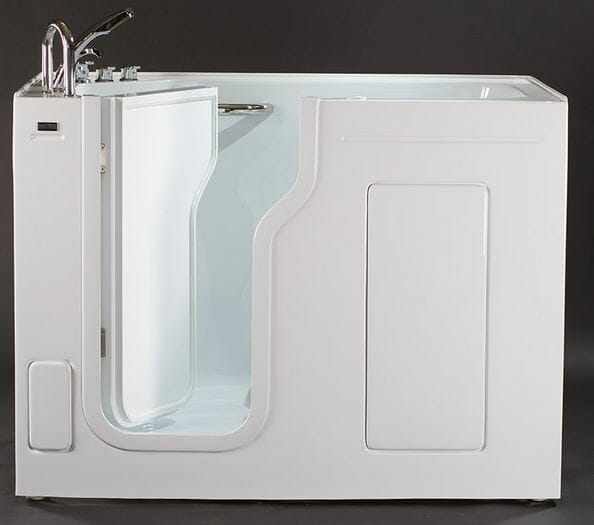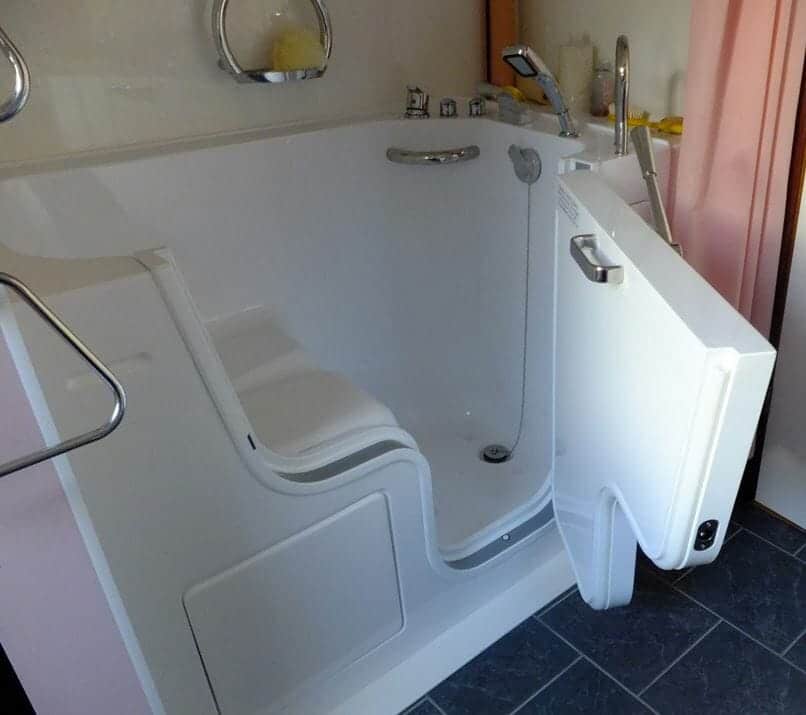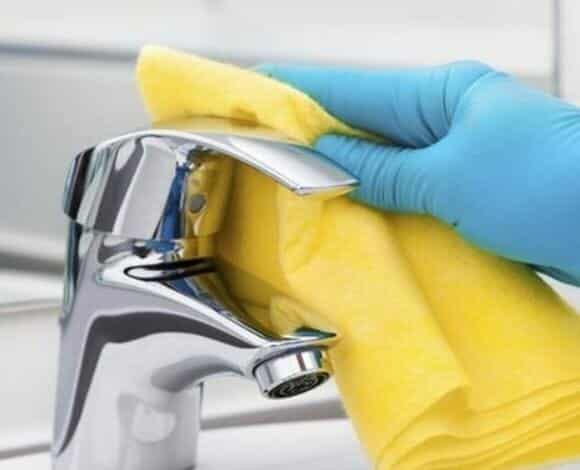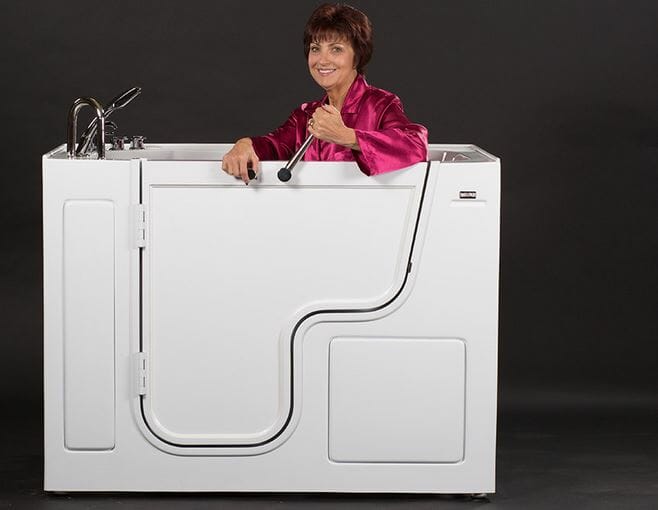
Walk-In Tub Costs: Factors to Consider Before Buying and Installation Guide
June 4, 2018
7 Factors to Consider When Buying a Walk-in Tub for Your Home
August 6, 2018A walk-in tub is used almost daily by several family members.
For this reason, it is absolutely necessary to clean the walk-in tub several times a week. Even after use, dirty streaks are often present, which would dry up quickly.
The walk-in tub is an important element in the bathroom. If you don’t maintain it and take extra care in using it the right way, it can cause serious mishaps or even death.
According to Telegraph report, Japan’s health ministry had conducted an investigation a few years ago after it was recorded that 14,000 people died every year (2012 – 2013) in the tub. This number was 3X as many as those who had an auto crash accidents.

The cause of deaths in the tub was attributed to heart palpitation, drowning, head injuries, and slippery due to inadequate maintenance of the tub.
On the mild side, your walk-in tub needs to sparkle, shine, and last longer.
In this guide, you will learn how to clean the walk-tub quickly and efficiently so you can protect yourself from dirt and injuries in the future.
Before you start cleaning, you need to know what type of finish your tub has. Most are made of porcelain, enamel, or acrylic.
If your bath is made of a more unusual material, such as natural stone, ask the manufacturer for appropriate cleaning instructions.
Which cleaning product to choose?
Since it’s easy to get lost among the countless bathroom products available on the market, which can ultimately cost quite a bit, why not opt for simplicity!
A homemade paste combining an equal amount of warm water and baking soda will do magic, especially in removing soap residue from the bath walls.
Another simple and natural option is to mix hot vinegar with water and a little dish soap. Get microfiber rags that trap dirt and give an impeccable shiny result.
If you prefer commercial products, be sure to buy a product that is not too abrasive, especially if your walk-in tub is made of acrylic, which scratches more easily.
Treatment of stains
For acrylic, the finish should reveal very few dark circles and spots. If this happens, try rubbing the stain with a small knob of white toothpaste.
For enamel, which is a more delicate material, be careful not to use any stain removers containing bleach. Mix a few drops of peroxide with baking soda and gently rub the stain.
For porcelain, magic eraser sponges can do a fantastic job without too much effort.
Basically, after each bath, the tub should be rinsed once with clean water to rid it of foam, oils, and grease.
Enamel and acrylic walk-in tubs are more susceptible to scratches, so only gentle soft cloths and microfiber cloths should be used when cleaning. Soft sponges can be used for stubborn dirt for easy scrubbing.
Anyone who then regularly takes care of the unsightly limescale deposits can relax comfortably in a spotless tub.
The right technique

Start by wiping the edges of the bath with a damp cloth to see if any stubborn stains remain on the walls. Treat stains as above if necessary.
Then apply the chosen cleaner (home or commercial) to the entire surface with circular movements, always starting with the walls and ending with the bottom of the walk-in tub.
The next step is the easiest, though most important. Leave the product on for about ten minutes to give it time to do its job. You don’t need to rub immediately.
Then gently rub the product onto the bath with circular movements. You don’t have to go back to the same place several times. Again, a soft or microfiber cloth is the best option.
Finally, rinse thoroughly with perfectly clean water. A very important step to prevent traces of the product from continuing to take effect.
The ultimate step is to dry the bath with a soft dry cloth. The secret of a shiny walk-in tub lies in this step.
Take preventive measures
To minimize your cleaning time, there’s no need to explain at length why quick rinsing and cleaning after each use is recommended. If you use bar soaps, try shower gels that leave much less soap residue on the tub.
A very big problem with walk-in tubs is usually the unsightly discolorations. They are caused by shampoo residues or soap residues that settle on the tub.
The residues adhere to the rough surfaces and grow into a layer of lime.
If you do not remove these deposits early, they will stick further into the surface and eventually no longer soften. The tub loses its shine and looks dirty even when freshly cleaned.
Clean the bath with home remedies:
- Immediately after bathing, dirt edges appear which must be removed promptly. This works particularly easily with water and cleaning agent. Rub it with a fresh lemon peel to maintain the shine of the tub.
- Over the years, lime spots in the tub are no longer a rarity. Mix vinegar with water or take citric acid and scrub the stains off. In most cases, this is already sufficient for a clean result.
- A nice shine makes the walk-in tub look like new again. But it does not need an expensive means. Just mix some salt, vinegar, and buttermilk. Put this mixture into the walk-in tub and rub it thoroughly with a cloth.
- Rust quickly develops around the drain in particular. You can remove it with vinegar and baking powder. Very stubborn rust stains must be treated more often.
- The hated yellow spots sometimes do not go away with a simple cleaning process. Prepare a mixture of salt and vinegar. Rub in the stains while the mixture remains on throughout the night. This will give you the best possible result.
- Of course, you must not neglect the fittings. You can clean them particularly easily with soda water.
- A discarded toothbrush is ideal for grooves and corners in the tub, allowing you to exert ideal pressure.
- Unfortunately, scratches cannot necessarily be avoided. But you don’t have to replace the walk-in tub. Small scratches can easily disappear with a simple metal polish.
- Buttermilk restores an incredibly intense shine to the entire tub. The pure buttermilk cleans not only the tub, but also the fittings and the drain. You can leave the buttermilk in the tub for several hours if the stains appear particularly stubborn.
- If the tub has dirt that does not respond to all of these household remedies, more drastic measures may be appropriate. Ideally, you should use a product from the trade that gets by with chlorine and thus thoroughly removes dirt from the tub. Ventilate thoroughly when using such cleaning products!
Cleaning the walk-in tub with washing powder
Instead of trying out various chemical clubs from the trade, you prefer to use tried and tested household aids for cleaning — such as washing powder.

Simply pour some of it directly (without water) into the tub and rub it with a damp sponge in gentle, circular movements. Leave to soak in, and then rinse with water.
Important: When cleaning walk-in tubs, only use soft rags or microfiber cloths, as the surfaces of steel enamel and acrylic tubs are susceptible to scratches.
1). Use baking powder for cleaning
You may have already guessed: Even the good, old baking powder is wonderfully suitable for cleaning tubs. Put plenty of it in the moistened tub. Leave on overnight, then rub gently with a soft cloth and rinse thoroughly with water.
2). Use vinegar against rust and lime stains
If unpleasant rust stains have formed at the outlet, you can remove them with a mixture of vinegar and baking powder. Then rinse with water.
Lime also has no chance against vinegar (or lemon juice or citric acid). However, to make cleaning a little gentler on the surface of your tub, you should always dilute acids with water.
3). Eliminate unsightly yellow discolorations
If over time your walk-in tub has become yellowish or essential oils has left their mark, you can counteract this with vinegar and salt.
Mix it and then spread it on the surface of the tub and leave it to work overnight. Then rinse thoroughly with water.

How to keep your walk-in tub clean as a preventive measure
The biggest problem with dirty walk-in tubs is usually that the dirt has enough time to eat into the tub. With simple means you keep the tub permanently clean and also prevent annoying discoloration.
After taking a relaxing bath, rinse your tub thoroughly several times. This prevents soap residues from depositing in the first place. Also clean the fittings briefly with a cloth.

In the words of Claire Lower:
“Give the tub a quick spray of all-purpose cleaner, wipe up any grody spots, and rinse it well. If your bathroom is in need of a deep clean anyway, go ahead and do that.”
As soon as you discover dirt, wipe it off so that the individual dirt deposits do not eat even more into the surface. When preparing fresh lemon in the kitchen, do not throw away the rind under any circumstances.
Rub the entire surface of the tub with it and give it a new shine. The time required is hardly worth mentioning, but you will certainly appreciate the result.
Cause of odors and dirt in the walk-in tub
As already mentioned, hair, dandruff and soap provide for the stubborn deposits in the drain pipe. This can result in musty smells. According to The Hunker, “Musty smells are common in drains, especially the tub drain where large amounts of water and dirt are constantly washed down the drain.”

The question of the cause of odors and blockages quickly arises. Finally, fresh water and fragrant shower gels provide an enchanting scent of skin and hair. The answer lies in the combination of dirt, organic material and soap.
Small residues stick to the inside of the pipes where bacteria decompose them. Rotten odors quickly develop, especially in a rarely used walk-in tub.
But also the tub plug and the drain valve itself are not spared from the greasy deposits and provide an unhygienic sight.
1). Remove dirt and hair
When you clean the walk-in tub, you also devote yourself to the drain. The smooth chrome surfaces can be easily wiped off with a soft sponge and a splash of cleaning agent.
Hard to reach areas are best cleaned with an old toothbrush. Is there a lot of hair in the drainpipe? With a round nose plier you can pull them out easily.
Shine a flashlight into the tube to see if you have removed all your hair. You discover greasy deposits? With the help of a small tube brush, these can also be easily removed.
Do not forget to remove all kinds of deposits from the drain plug. Soap residues and dirt can be easily removed with a piece of toilet paper or a little kitchen paper. For stubborn stains, use a toothbrush and a little vinegar water.
2). Smelly drains
From time to time, a nasty smell can emerge from the drain of the space-saving tub — even if you clean it regularly.
Then it is likely that dirt remains have settled further down. Usually you can remove the stink with several liters of hot water. To do this, pour the water directly into the drain.
The stench doesn’t go away? No problem, because with a few clever remedies it will soon smell fresh again in the bathroom.
3). Clean clogged tub drain
If hair, dirt, and lime have clogged the pipe, the bath water no longer drains off. But don’t worry, this problem is also easy to solve. If the water accumulates only slightly, a mixture of vinegar essence and baking powder also helps.
Add baking soda or baking powder to the drain and add some vinegar. Cover the opening with a damp cloth and wait about 20 minutes. Then add hot water. The water should be draining.
Takeaway
There you have it. The most effective ways to keep the walk-in tub clean and safe for bathing, as well as minimize risk. However, if the bathwater of the full Duo walk-in tub does not drain off, use pipe cleaning spiral.
The clogging can also be loosened with a long and thin pipe cleaning spiral. Insert the spiral into the pipe and you’ll be just fine.


